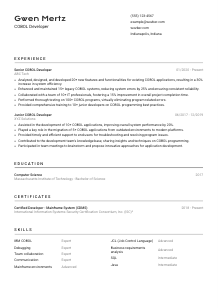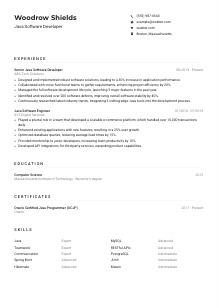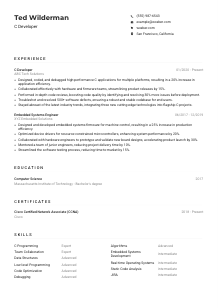COBOL Developer Resume Example
Cracking COBOL code, but your resume looks ancient? Dive into this COBOL Developer resume example, written with Wozber free resume builder. It illustrates how you can modernize your programming prowess to align with job demands, ensuring your career stays as robust as your legacy systems!

How to write a COBOL Developer resume?
Hello, aspiring COBOL Developer! The quest for landing your dream job starts with one crucial document: your resume. Today, we dive headfirst into the art of crafting a resume designed specifically for a COBOL Developer position. Leveraging the power of Wozber's free resume builder, including its ATS-friendly resume templates and ATS resume scanner, we'll navigate the intricacies of creating a document that not only speaks your professional language but also passes through Applicant Tracking Systems with flying colors.
Ready to transform your resume into a gateway of opportunities? Let's embark on this journey together.
Personal Details
The Personal Details section is more than just an introduction; it's your chance to ensure your resume lands in the right hands by amplifying your fit for the COBOL Developer role right from the start. Here's how to tailor this section impeccably.
1. Ensure Your Name Stands Out
Make your name memorable by employing a clear and bold font. This is your headline, the banner under which all your achievements will be presented.
2. Job Title Precision
Aligning with the COBOL Developer position immediately below your name positions you as a perfect candidate right off the bat. It's like telling the hiring manager, "This is the exact role I'm prepared and excited to fill."
3. Essential Contact Info
Include your phone number and a professional email. In the world of COBOL development, details matter – ensure these basics are error-free.
4. Location Matters
"Located in Indianapolis, IN" – This simple line aligns you with one of the job's logistical requirements, showcasing your readiness and reducing potential hiring complexities.
5. LinkedIn or Personal Website
Given the evolving nature of COBOL systems, displaying a link to a well-maintained LinkedIn profile or a personal website can exhibit your continuous learning and projects beyond what a resume can hold.
Takeaway
Consider the Personal Details section as your opportunity to ensure the hiring manager has no doubts about contacting you. Every detail counts in sketching a professional and approachable image, paving the way for the rest of your resume to shine.





Experience
The Experience section is where you get to flaunt your COBOL skills and professional milestones. It's your time to connect your background directly with what the COBOL Developer position entails.
- Analyzed, designed, and developed 20+ new features and functionalities for existing COBOL applications, resulting in a 30% increase in system efficiency.
- Enhanced and maintained 15+ legacy COBOL systems, reducing system errors by 25% and ensuring consistent reliability.
- Collaborated with a team of 10+ IT professionals, fostering a 15% improvement in overall project completion time.
- Performed thorough testing on 100+ COBOL programs, virtually eliminating program‑related errors.
- Provided comprehensive training to 10+ junior developers on COBOL programming best practices.
- Assisted in the development of 10+ COBOL applications, improving overall system performance by 20%.
- Played a key role in the migration of 5+ COBOL applications from outdated environments to modern platforms.
- Provided timely and efficient support to end‑users for troubleshooting and resolving program issues.
- Contributed to the development team's knowledge base, sharing insights and techniques on COBOL programming.
- Participated in team meetings to brainstorm and propose innovative approaches for application development.
1. Break Down the Job Requirements
Start by dissecting the job posting. Recognize terms like "IBM COBOL", "JCL", and phrases like "enhancing and maintaining legacy systems" as your keywords for tailoring.
2. Chronological Format
Listing your roles from the most recent backward ensures clarity. For instance, stating your position as a Senior COBOL Developer first underscores your ascending trajectory in the field.
3. Accomplishments Over Tasks
Highlight your achievements, such as "Developed 20+ new features for COBOL applications, increasing system efficiency by 30%". Quantify your impact to give hiring managers a concrete understanding of your capabilities.
4. Quantification Is Key
Numbers speak louder in resumes. By quantifying your achievements, you provide a measurably accurate depiction of your professional impacts.
5. Relevance Above All
Ensure every point made ties back to a requirement or responsibility outlined in the job description. Your goal is to make it impossible for the hiring manager to overlook your suitability for the role.
Takeaway
The Experience section is your storytelling platform, where each bullet point serves as a testament to your prowess as a COBOL Developer. It's about painting a picture of your professional journey with strokes that resonate with the role you're aiming for. Use this space judiciously to align your past with your desired future.
Education
While your experience speaks volumes, your education is the cornerstone of your technical knowledge. Here's how to ensure your educational background aligns perfectly with the COBOL Developer position requirements.
1. Match the Requirement
The job calls for a "Bachelor's degree in Computer Science or related field." This should be prominently featured on your resume to meet the basic educational threshold.
2. Simplify and Clarify
There's beauty in simplicity. State your degree, the awarding institution, and the graduation year in a clean layout to ensure ease of reading.
3. Degree Alignment
For a COBOL Developer, your "Bachelor of Science in Computer Science" not only meets the stated requirement but underscores your foundational understanding of programming principles.
4. Course Highlights
In some cases, listing specific courses can underscore your preparedness, especially if they directly relate to COBOL or mainframe environments. However, prioritize overall degree relevance.
5. Extra Achievements
If you have pertinent honors or extracurriculars, consider including them. Although, remember that for seasoned roles, professional experience and skills take precedence.
Takeaway
Your educational background acts as the proof of your technical proficiency and readiness to handle COBOL development tasks. Ensure it speaks to the requirements of the job succinctly and effectively. It's about showing you have the necessary knowledge base to jump right into the role.
Certificates
Continuing education through certifications can set you apart as a COBOL Developer. Here's how to strategically feature them on your resume.
1. Review Job Requirements
While the job description may not specify certifications, including relevant ones, like "Certified Developer - Mainframe System (CDMS)", signals your commitment to your craft.
2. Handpick Relevant Certificates
Curate your certificates list to include those most relevant to the COBOL Developer role, emphasizing your specialized knowledge and up-to-date skills.
3. Validity and Recency
Ensure to include the dates of your certifications to demonstrate their current relevance.
4. An Ongoing Journey
In the tech field, learning never stops. Show an ongoing commitment to professional development by seeking out and listing new, relevant certifications.
Takeaway
Certificates are a testament to your dedication to staying on the cutting edge of COBOL development. Display them proudly on your resume, as they're concrete indicators of your competencies and continuous learning efforts.
Skills
The Skills section is the quick-reference guide to your capabilities. For a COBOL Developer, it's crucial to strike a balance between hard and soft skills, ensuring your resume resonates well with the job's technical and interpersonal demands.
1. Decipher the Job Description
Identify both explicit skills, like "IBM COBOL", and implicit skills, such as "team collaboration", directly from the job posting.
2. Showcase Your Best Skills
List the skills that you most excel in and that are most relevant to the job, supporting them with evidence from your experience where possible.
3. Organize for Impact
Prioritize skills that match the job description, keeping your list neat and focused. Overloading with every skill you possess can dilute the impact of your core strengths.
Takeaway
A well-crafted Skills section is like a highlight reel of your professional capabilities. It's your chance to impress upon hiring managers that you possess not just the technical prowess required for COBOL development but also the soft skills necessary for team collaboration and project success.
Languages
In a global business environment, language skills can be a surprising asset. For a COBOL Developer, highlighting language proficiency may not be a core requirement, but it can indicate your ability to thrive in diverse teams or international settings.
1. Survey the Job Requirements
For this COBOL Developer position, proficiency in English is a must. This should be unequivocally stated in your resume.
2. Showcase Your Linguistic Range
After ensuring your proficiency in English is clear, listing additional languages could demonstrate your broader communication skills.
3. Rank Your Proficiency Honestly
Accuracy in describing your language abilities ensures expectations are correctly set and can prevent misunderstandings down the line.
4. Additional Languages as a Plus
If the job involves potential international exposure or teams from diverse linguistic backgrounds, your ability to speak additional languages could play to your advantage.
5. Language Skills Reflect Potential
Your proficiency in languages suggests adaptability and an ability to learn - traits highly valued in any field, including COBOL development.
Takeaway
While direct language requirements for COBOL Developers may be minimal, demonstrating your linguistic capabilities can add a layer of appeal to your application. It showcases not just your communication skills but also a global mindset - an invaluable asset in today's interconnected world.
Summary
Crafting a compelling Summary is your chance to captivate your audience from the get-go. For a COBOL Developer, this means articulating your essence, your achievements, and how you align with the role's needs succinctly.
1. Start with the Core
Initiate your pitch with an attention-grabbing statement that encapsulates your professional identity as a COBOL Developer. This sets the tone and intention of your resume.
2. Address the Essentials
Segue into how your skills and unique accomplishments pitch you as the ideal candidate for the job. Remember to align with the job description, highlighting your proficiency in areas like "IBM COBOL" and your experience in "enhancing and maintaining legacy systems".
3. Conciseness Wins
Keep your summary tight and impactful. Aim for a balance between being informative and engaging, ensuring every word earns its place.
4. The Summary as Your Brand
Think of your Summary as the tagline to the brand that is 'You'. It's your chance to leave a memorable impression that motivates the hiring manager to delve deeper into your resume.
Takeaway
A well-tuned Summary not only showcases your qualifications but also demonstrates your passion for COBOL development and your alignment with the role's demands. Let it be the hook that draws the hiring manager in, eager to learn more about how you will contribute to their team's success.
Launching Your COBOL Developer Journey
You're now equipped with the know-how to craft a COBOL Developer resume that stands out, impresses hiring managers, and passes through ATS filters. Remember, your resume is your story - let it reflect your passion, expertise, and readiness for your next challenge. With these tips and Wozber's free resume builder, including its ATS-friendly resume format and ATS resume scanner, you're on your way to securing your dream role.
The world of COBOL development awaits your unique contributions. Embrace the journey, and here's to your success!

- Bachelor's degree in Computer Science or related field.
- Minimum of 3 years of professional experience in COBOL development.
- Strong proficiency in Mainframe environments, specifically with IBM COBOL and JCL.
- Experience in debugging, enhancing, and implementing complex COBOL programs.
- Demonstrated collaboration and communication skills in a team-oriented environment.
- Proficient in English is a condition of employment.
- Must be located in Indianapolis, IN.
- Analyze, design, and develop new features and functionalities for existing COBOL applications.
- Maintain and enhance legacy COBOL systems to ensure optimum performance and reliability.
- Collaborate with cross-functional teams to understand business requirements and provide effective technical solutions.
- Perform thorough testing and debugging of COBOL programs to ensure error-free operations.
- Provide documentation, training, and support for COBOL applications and systems.















